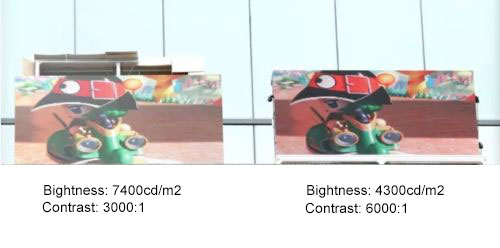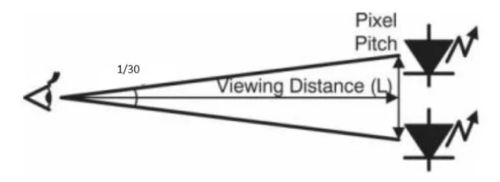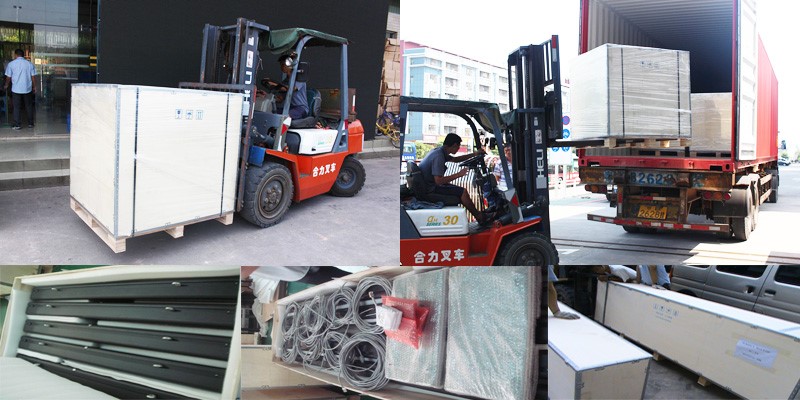CUSTOM SUPPORT & SALE
CUSTOM SUPPORT & SALE
In the domestic led display industry, brightness has always been the most as long as the indicators we use to evaluate the display effect, especially for outdoor use of the screen. Over time, the higher the brightness is, the better the misunderstanding is, but ignores another indicator that is extremely important to the display effect—contrast.
According to the industry standard SJ/T11281-2007 "Light Emitting Diode (LED) Display Test Method", the display under a certain ambient illumination, the ratio of the maximum brightness and background brightness is called the highest contrast (see the specific test conditions and methods This standard). For example, when the screen is in full white status, the brightness is 5000cd/m2, and the full black status is 1cd/m2, so the contrast of the screen is 4999:1. The definition of contrast actually emphasizes the visibility of the display screen in the use environment. Compared with the brightness index, the contrast index increases the brightness of the entire black screen, and the brightness of the full black screen is different from the ambient light and the screen body ( The reflective properties of LEDs and masks are closely related. The following outdoor comparative examples can be seen that the screen with high brightness and low contrast does not have a relatively low brightness but high contrast screen.

In addition, even with a constant contrast, the higher the brightness, the better. The screen with too high brightness may bring about the following three problems: (1) high energy consumption, (2) light pollution, and (3) reduced hardware life.
In summary, we believe that the brightness of the led display is not as high as possible, and the contrast index is better than the height index to show the effect of the display; and in the condition of a certain contrast, the higher the brightness, the better.
The larger the viewing angle of the led display, the better?
Before discussing the size of the perspective, we also need to clarify the concept of perspective. Many players in the industry set the viewing angle specification to be inaccurate, and think that the perspective of the display content is the range of viewing angles, but it is not. According to the definition of the industry standard SJ/T 11281-2007 "Light Emitting Diode (LED) Display Test Method", assuming that the brightness of the normal direction of the display screen is Lf, the brightness of the display screen is detected from the left and right sides of the center line of the display screen. When the luminance values on the left and right sides fall to Lf/2, the angle formed between the two observation lines is called the viewing angle in the horizontal direction of the display screen. Vertical perspective is the same.
The perspective of the LED itself is also based on the same definition above. Due to the definition of the brightness test on the display screen, the optical probe needs to replace at least 16 LED pixel points, which may cause the viewing angle of the screen to be slightly larger than the viewing angle of the used LED (assuming that the mask does not block light). As shown in the example in Figure 3, a led display made from a 100-degree viewing angle LED has a 134 degree viewing angle.
Then the perspective of the led display is not the bigger the better? In fact, this depends on the needs of different applications. For example, in road traffic information screens, since the audience of the display content is only a road vehicle, the viewing angle is usually only about 30 degrees. An excessively large angle of view will result in light pollution at other angles and lower energy efficiency. For example, the exterior wall of outdoor buildings. The advertising display shows that the audience of the content is the passersby on the street, so the horizontal viewing angle needs to be relatively large, and the vertical viewing angle should be minimized.
The larger the display pixel density, the better?
The display pixel density seems to be always bigger the better, because it means that the theoretical display screen will be more delicate. However, the pixel density in the end how much, we think that need to be considered from the following three aspects.
First, the human eye's resolving power (without considering human eye observation equipment. According to "TCO Certified Displays 7.0" requirements, human eyes need at least 30 display pixels within a 1-degree viewing angle, which means a single dot spacing. The perspective requirement is 1/30
The limit of the two point light sources can be distinguished by the human eye is that these two point light sources and the human eye form an arc angle of 1/60, then the distance between the two points (Dpp) and the observation distance (L) has the following relationship:


Second, the load capacity of the chip source, video processor and driver chip. If the resolution of the source is much lower than the resolution of the display device, the display device obviously has excess capacity. For video processors and driver chips, if the capacity is kept constant, the increase in load pixels will cause a reduction in the refresh rate or grayscale. In many cases, the low refresh or low gray display is worse than the pixel density.
Third, the cost. The first increase in the number of LEDs will increase with the square of the pixel resolution. PCB board costs also increase because of the more responsible circuit design per unit area. In addition, if you do not want to sacrifice the number of scans, refresh rate or gray scale, the cost of driving components will also increase dramatically.
Contact us to learn more about led display screen now.
Why Choose Colorlight LED To Be Your Partner ? 12 Years Experience on Led Display Screen Manufacturing. Excellent after-sale service to meet your standards of excellence. 3 Years High Quality Warranty provided. 5% Spare Parts for Your Order Replacement. Convenient online Store (www.ledinthebox.com) for you to order LED display parts with best Price and fast DHL shipping. High Quality With Global Standards,CE EMC-B,RoHs,FCC,UL Certificated.


Contact: Lee
Phone: +86-132-6566-7728
E-mail: info@colorlitled.com
Add: Tangtou Industrial Park,Shiyan,Baoan,Shenzhen